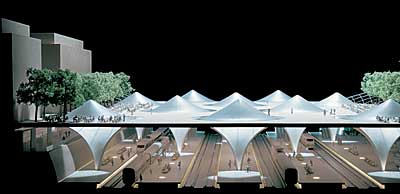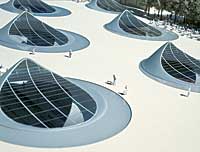The Zero Effect
The plan, which won an AIA Honor Award in 2006 and is available on the firm's Web site (www.mithun.com), represents an attempt to define carbon-neutral design. While the term "zero carbon" gets bandied about, most designers mean "net" zero, where absorption of carbon is equal to or greater than emission, hence the neutrality argument. And when talk turns to carbon, more often than not the discussion concerns energy and its parent, fossil fuels. The Department of Energy (DOE) attributes 98 percent of America's carbon dioxide emissions to the combustion of fossil fuels. It's pretty straightforward to determine a building's energy use, to trace it to its source (probably a coal or natural gas-fired power plant), and to make a rough estimate of how much CO2 finds its way into the atmosphere every year when you turn on your lights or tweak your thermostat (see the EPA's quick calculator based on kilowatt-hours usage atwww.epa.gov/cleanrgy/powerprofiler.htm). Past utility bills or electricity-demand-consumption predictions by electrical engineers, environmental consultants, and utility companies-all of which are likely based on previously known consumption patterns-form the baseline for any discussion of a building's energy reduction or generation. But what do we mean when we set out to make a building "zero energy"?
Zero-sum games
The American Society of Heating, Refrigerating, and Air Conditioning Engineers (ASHRAE) provided one of the more concise statements on zero-energy buildings in "Understanding Zero-Energy Buildings," which appeared in its September 2006 journal (www.ashrae.org). The authors, Paul Torcellini, an engineer at the National Renewable Energy Laboratory (NREL), and Drury Crawley, with the DOE's Office of Building Technologies, subclassify the concept for buildings in four schemes: net zero source energy, net zero site energy, net zero energy cost, and net zero energy emissions.
Net zero source energy compares the building's energy consumption and production to that of the utility source. Since utilities rely on multiple generation plants and transmission systems, this concept generally proves too difficult to quantify and is therefore rarely used in architecture. The net zero site energy concept measures energy consumption within the boundaries of the building's site, ignoring whether the utility source is coal or wind. This applies more generally to what architects try to achieve, since even so-called "off-the-grid" buildings loaded with photovoltaics (PV) and wind turbines still typically connect to utility transmission lines for backup power. Skidmore, Owings & Merrill's design for Pearl River Tower [record, December 2006, page 172], in Guangzhou, China, exemplifies this approach. The third element, net zero energy cost, relies on volatile energy rates-a notoriously difficult metric-to reach a balance between the energy generated on-site and sold to the utility versus the energy supplied by the utility. Finally, the concept of net zero energy emissions only measures the emissions produced by the generation of power to meet the building's total energy needs, which can also prove difficult with a utility company dependent on multiple sources at any given time.
Architects approach this topic in multiple ways, but the ASHRAE article stresses the need to define the project's goal from the beginning to guide the design team in its decisions. The Dusseldorf, Germany−based firm Ingenhoven Architekten established a net zero site energy constraint on its competition-winning scheme for the Stuttgart Main Station, an expansion and upgrade to the city's train station. The design of the building, for completion in 2013, essentially amounts to a roof to cover below-grade train tracks, a public park, and some interior circulation space. Christoph Ingenhoven, the firm's principal, describes the design as a 21st-century response to a 19th-century problem. "It's very difficult to get a zero-energy building," he says, noting that although his own house is nearly zero energy, he still purchases some power from a renewably sourced utility company.












